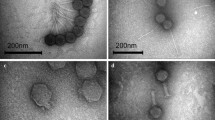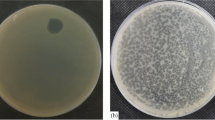Abstract
In this work, a final piece of evidence proving that bacteria Pseudomonas aeruginosa are capable of transition to the pseudolysogenic state after infection with φKZ-like phages has been produced. It was shown that the decisive factor in this process is multiple infection of bacteria with bacteriophages belonging to this genus. In the course of this work, stable clinical isolates of bacteria liberating novel bacteriophages of this genus (Che2/2 and Che21/5) were detected and attributed to species φKZ and EL, respectively, according to their phenotypic characters and the results of DNA analysis. For three bacteriophages belonging to species EL (EL, RU, and Che21/5), mutants with disorders in the capability for pseudolysogenization were isolated. One of the mutants of phage EL possesses properties of virulent mutants of typical temperate phages (vir mutant). This mutant fails to form pseudolysogens and, moreover, provides the effect of dominance upon coinfection of bacteria with the wild-type phage EL, but however is unable to exhibit this effect upon joint infection of bacteria with wild-type phages of species φKZ and Lin68. It is assumed that the effect of pseudolysogeny may be connected with functioning of φKZ and EL genes that control the products similar to repressors of other phages. Because earlier wild-type φKZ-like phages were shown to be present in commercial phage-therapeutic preparations (which represents certain problems), it is expedient to use virulent mutants of phages belonging to this genus rather than phages of the wild type.
Similar content being viewed by others
References
Krylov, V.N., Dela Cruz, D.M., Hertveldt, K., and Ackermann, H.-W., “φKZ-Like Viruses”, a Proposed New Genus of Myovirus Bacteriophages, Arch. Virol., 2007, vol. 152, no. 10, pp. 1955–1959.
Doermann, A.H., Lysis and Lysis Inhibition with Escherichia coli Bacteriophage, J. Bacteriol., 1948, vol. 55, no. 2, pp. 257–276.
Krylov, V.N. and Zhazykov, I.Zh., Pseudomonas aeruginosa Bacteriophage φKZ as a Probable Model for Analysis of Genetic Control of Morphogenesis, Genetika (Moscow), 1978, vol. 14, no. 4, pp. 678–685.
Burkal’tseva, M.V., Krylov, V.N., Pleteneva, E.A., et al., Phenogenetic Characterization of a Group of Giant φKZ-Like Bacteriophages of Pseudomonas aeruginosa, Russ. J. Genet., 2002, vol. 38, no. 11, pp. 1242–1250.
Krylov, V.N., Burkal’tseva, M.V., Sykilinda, N.N., et al., Comparison of Genomes of New Gigantic Pseudomonas aeruginosa Phages from Native Populations from Different Regions, Russ. J. Genet., 2004, vol. 40, no. 4, pp. 363–368.
Mesyanzhinov, V.V., Robben, J., Grymonprez, B., et al., The Genome of Bacteriophage φKZ of Pseudomonas aeruginosa, J. Mol. Biol., 2002, vol. 317, pp. 1–19.
Hertveldt, K., Lavigne, R., Pleteneva, E., et al., Genome Comparison of Pseudomonas aeruginosa Large Phages, J. Mol. Biol., 2005, vol. 2, no. 354, no. 3, pp. 536–545.
Shaburova, O.V., Hertveldt, K., de la Cruz, D.M.A., et al., Comparison of New Giant Bacteriophages OBP and LU11 of Soil Pseudomonads with Bacteriophages of the φKZ-Supergroup of Pseudomonas aeruginosa, Russ. J. Genet., 2006, vol. 42, no. 8, pp. 877–885.
Thomas, J.A., Rolando, M.R., Carroll, C.A., et al., Characterization of Pseudomonas chlororaphis Myovirus 201varphi2-1 via Genomic Sequencing, Mass Spectrometry, and Electron Microscopy, Virology, 2008, vol. 5, no. 376, no. 2, pp. 330–338.
Sharibzhanova, T.O., Akhverdyan, V.Z., and Krylov, V.N., A Comparative Study of DNA Homology and Morphology of Pseudomonas aeruginosa Bacteriophages to Reveal Phylogenetic Relationships and for an Express Classification, Russ. J. Genet., 1992, vol. 28, no. 3, pp. 24–32.
Khemayan, K., Pasharawipas, T., Puiprom, O., et al., Unstable Lysogeny and Pseudolysogeny in Vibrio harveyi Siphovirus-Like Phage 1, Appl. Environ. Microbiol., 2006, vol. 72, no. 2, pp. 1355–1363.
Sakaguchi, Y., Hayashi, T., Kurokawa, K., et al., The Genome Sequence of Clostridium botulinum Type C Neurotoxin-Converting Phage and the Molecular Mechanisms of Unstable Lysogeny, Proc. Natl. Acad. Sci. USA, 2005, vol. 29, no. 102, pp. 17472–17477.
Ripp, S. and Miller, R.V., Dynamics of the Pseudolysogenic Response in Slowly Growing Cells of Pseudomonas aeruginosa, Microbiology, 1998, vol. 144, no. 8, pp. 2225–2232.
Los, M., Wegrzyn, G., and Neubauer, P., A Role for Bacteriophage T4 rI Gene Function in the Control of Phage Development during Pseudolysogeny and in Slowly Growing Host Cells, Res. Microbiol., 2003, vol. 154, no. 8, pp. 547–552.
Pleteneva, E.A., Shaburova, O.V., and Krylov, V.N., A Formal Scheme of Adsorptional Receptors in Pseudomonas aeruginosa and Possibilities for Its Practical Implementation, Russ. J. Genet., 2009, vol. 45, no. 1, pp. 35–40.
Miller, J.H., Experiments in Molecular Genetics, New York: Cold Spring Harbor Lab., 1972.
Adams, M.H., Bacteriophages, New York: Interscience, 1959, pp. 29–30 and 450–451.
Sambrook, J., Fritsch, E.F., and Maniatis, T., Molecular Cloning: A Laboratory Manual, Cold Spring Harbor: Cold Spring Harbor Lab., 1989.
Warren, R.J. and Bose, S.K., Bacteriophage-Induced Inhibition of Host Functions: I. Degradation of Escherichia coli Deoxyribonucleic Acid after T4 Infection, J. Virol., 1968, vol. 2, no. 4, pp. 327–334.
Mathews, C.K. and Kessin, R.H., Control of Bacteriophage-Induced Enzyme Synthesis in Cells Infected with a Temperature-Sensitive Mutant, J. Virol., 1967, vol. 1, no. 1, pp. 92–96.
Author information
Authors and Affiliations
Corresponding author
Additional information
Original Russian Text © E.A. Pleteneva, S.V. Krylov, O.V. Shaburova, M.V. Bourkal’tseva, K.A. Miroshnikov, V.N. Krylov, 2010, published in Genetika, 2010, Vol. 46, No. 1, pp. 26–32.
Rights and permissions
About this article
Cite this article
Pleteneva, E.A., Krylov, S.V., Shaburova, O.V. et al. Pseudolysogeny of Pseudomonas aeruginosa bacteria infected with φKZ-like bacteriophages. Russ J Genet 46, 20–25 (2010). https://doi.org/10.1134/S1022795410010047
Received:
Published:
Issue Date:
DOI: https://doi.org/10.1134/S1022795410010047




